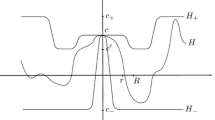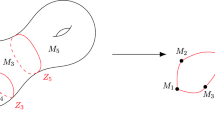Abstract
A very natural and fundamental question (both from a historical and a mathematical point of view) is that of existence of periodic orbits of Hamiltonian flows on a fixed energy hypersurface. In 1978 Alan Weinstein conjectured that a geometric property of the hypersurface under consideration would provide a sufficient condition for the existence of such orbits. He called hypersurfaces with this property hypersurfaces of contact type. This article briefly describes the history of the Weinstein Conjecture, which has been one of the major driving forces behind the development of symplectic geometry at the end of the twentieth century, leading to some of the most fruitful interactions between analysis, geometry and topology. Weinstein’s Conjecture has been proved in a number of significant cases but remains, in its most general form, an extremely interesting and challenging open problem.







Similar content being viewed by others
Notes
This result is sometimes referred to as the principle of the symplectic camel.
According to the Oxford English Dictionary, the word symplectic was introduced by Weyl, who proposed to substitute the name ‘complex group’ by the corresponding Greek adjective ‘symplectic’. On a trip to Asia, Klaus Niederkrüger learned that the Chinese character for symplectic is one whose standard meaning is ‘hot, spicy’, so that, at least in China, symplectic geometry is ‘hot geometry’!
References
Abbas, C., Cieliebak, K., Hofer, H.: The Weinstein conjecture for planar contact structures in dimension three. Comment. Math. Helv. 80, 771–793 (2005)
Albers, P., Hofer, H.: On the Weinstein conjecture in higher dimensions. Comment. Math. Helv. 84, 429–436 (2009)
van den Berg, J.B., Pasquotto, F., Vandervorst, R.C.: Closed characteristics on non-compact hypersurfaces in ℝ2n. Math. Ann. 343, 247–284 (2009)
Bourgeois, F.: A survey of contact homology. In: Abreu, M., Lalonde, F., Polterovich, L. (eds.) New Perspectives and Challenges in Symplectic Field Theory. CRM Proceedings & Lecture Notes, vol. 49, pp. 45–71. AMS and CRM, Providence (2009)
Bourgeois, F., Eliashberg, Y., Hofer, H., Wysocki, K., Zehnder, E.: Compactness results in symplectic field theory. Geom. Topol. 7, 799–888 (2003)
Floer, A.: Symplectic fixed points and holomorphic spheres. Comm. Math. Phys. 120, 575–611 (1989)
Geiges, H., Zehmisch, K.: Symplectic cobordisms and the strong Weinstein conjecture. Math. Proc. Cambridge Philos. Soc. (2011, to appear)
Gromov, M.: Pseudo holomorphic curves in symplectic manifolds. Invent. Math. 82, 307–347 (1985)
Hofer, H.: Pseudoholomorphic curves in symplectizations with applications to the Weinstein conjecture in dimension three. Invent. Math. 114, 515–563 (1993)
Niederkrüger, K., Rechtman, A.: The Weinstein conjecture in the presence of submanifolds having a Legendrian foliation. J. Topol. Anal. 3, 405–421 (2011)
Pasquotto, F.: Een korte geschiedenis van het vermoeden van Weinstein. Nieuw Arch. Wiskd. 12, 96–100 (2011)
Rabinowitz, P.H.: Periodic solutions of Hamiltonian systems. Commun. Pure Appl. Math. 31, 157–184 (1978)
Ranicki, A.: High-dimensional Knot Theory. Springer Monographs in Mathematics. Springer, New York (1998)
Taubes, C.H.: The Seiberg-Witten equations and the Weinstein conjecture. Geom. Topol. 11, 2117–2202 (2007)
Viterbo, C.: A proof of Weinstein’s conjecture in ℝ2n. Ann. Inst. Henri Poincaré, Anal. Non Linéaire 4, 337–356 (1987)
Weinstein, A.: On the hypotheses of Rabinowitz’ periodic orbit theorems. J. Differ. Equ. 33, 353–358 (1979)
Author information
Authors and Affiliations
Corresponding author
Additional information
This article is an extended and translated version of Een korte geschiedenis van het vermoeden van Weinstein [11], which originally appeared in the Nieuw Archief voor Wiskunde, the journal of the Royal Dutch Mathematical Society (KWG). Jahresbericht der DMV and the author are grateful to the KWG for their kind permission to reprint the article. The author would also like to thank Hansjörg Geiges and Kai Zehmisch for their careful reading of the translation and for many useful comments.
Rights and permissions
About this article
Cite this article
Pasquotto, F. A Short History of the Weinstein Conjecture. Jahresber. Dtsch. Math. Ver. 114, 119–130 (2012). https://doi.org/10.1365/s13291-012-0051-1
Received:
Published:
Issue Date:
DOI: https://doi.org/10.1365/s13291-012-0051-1




